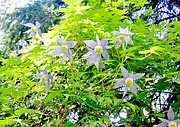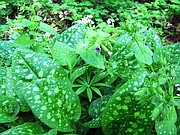Ornamental greenery enhances landscape
Walking along the old stone path into my battle-scarred-but-still-lovely (to me) sanctuary garden, I can’t help but notice the peace that immediately wraps around me from the many shades of green. No blossoms are really necessary here for the multi-patterned leaves offer enough variety in shape and shade.
The many ornamental-leaved natives and cultivars — such as the beautiful Solomon’s Seal with it’s fabulous arching stems that hold tiny drooping florets — along with Brunnera, Pulmonaria (Lungwort), Hostas and a multitude of ferns, each provide their own unique beauty. Many of these do offer the bonus of small or even tiny flowers but it’s the green that matters.
This garden hosts a lavish 20-some year-old Clematis that has climbed up into a supporting Serviceberry tree (which has long-outgrown the title of “bush.”) The short-lived blue of its blossoms (pictured) turn into long-lasting poufs of fluff that carry the seeds to ensure years more of beauty.
There are a few flowers — very few, actually in the sanctuary — but generally they enhance the greens with their lovely presence — notably the Foxglove and Bleeding heart. Of course, the beloved violets take over in the spring in a lavish and fragrant carpet.
Other parts of the property hold green-leaved beauty with the shrubs which are one of the most important aspects of the landscape, since their branches can shelter nesting birds, and those with lavish bloom are lifesavers for hummingbirds and pollinating bees and insects as well.
My native shrubs — along with multitudes of wild roses - include Ninebark, Pachistima, Serviceberry, Mt. Ash, Red osier dogwood and Elderberry — after a nearly 40-year residency, these are all mature (as is their tender). Planting time is pretty much over now, but use the winter to study or inquire into any of these or their cultivars. In the past few years, amazing developments have taken place that not only strengthen cultivars but provide for repeat blooming throughout the season. A former column pointed out a few of these, including some non-native but valuable and hardy beauties that include Viburnum, Hydrangeas, Weigela and Azaleas, that will explore possibilities for mixing and matching for a fabulous spring/summer/fall show.
Viburnums offer versatility, practicality and beauty. Our native Viburnum edule — or Highbush cranberry (not to be confused with bog or edible cranberries (vaccinium), has clustered white flowers and berries appreciated by birds. I once pointed out that the fruits of “wild” Viburnum were once gathered by the earliest settlers and stewed, sugared and eaten as a sauce similar to cranberry sauce. Now there are literally hundreds of Vibernumcultivars , many of which have been trained for re-blooming.
Hydrangeas range from short to mid-sized to tall, and now boasts the classic old "Snowball" blossoms in pink as well as white, as well as pannicle and lace-cap choices in white, lime, pink, red-pink and a lovely lavender, with leaf variations from honey-green to brilliant emerald. Generally hardy in cold climates to Zone 4, hydrangeas like full sun but accept partial shade and forms a 4 to 6-foot tall shrub that blooms from midsummer into late fall.
Weigela (Wy-GEE-la), are not a native based shrub here, but are so gorgeous they must be considered. They appeal to hummingbirds, butterflies and bees of every ilk while offering lot of stem/branch protection for nesting birds and glory to the garden. Many Weigela varieties boast repeat blooms, and some offer bloom throughout summer and into late fall. There are many other choices of equal beauty and color in this hardy tubular-bloomed shrub in which often offers unexpected leaf color for a surprising focal point.Azaleas generally produce a flush of blooms in the spring, with some also producing fall blooms. Breeders worked hard to enhance these traits by crossing the rare repeat bloomers with summer blooming species to develop shrubs that will bloom reliably in spring, summer and fall, providing choices for all season bloom. The fabulous Northern Lights series that were bred in Minnesota for hardiness, beauty and scent include a variety of vibrant color choices along with the delight of long-lasting bloom.
I’ve tried to stick to the “green” aspect of today’s column — but one does become enthusiastic — anyhow, you’ve got a whole winter coming up to plan for some “greenery” in your landscape. Enjoy!
Valle Novak writes the Country Chef and Weekend Gardener columns for the Daily Bee. She can be reached at bcdailybee@bonnercountydailybee.com or by phone at 208-265-4688 between the hours of 8 a.m. to 7 p.m.







